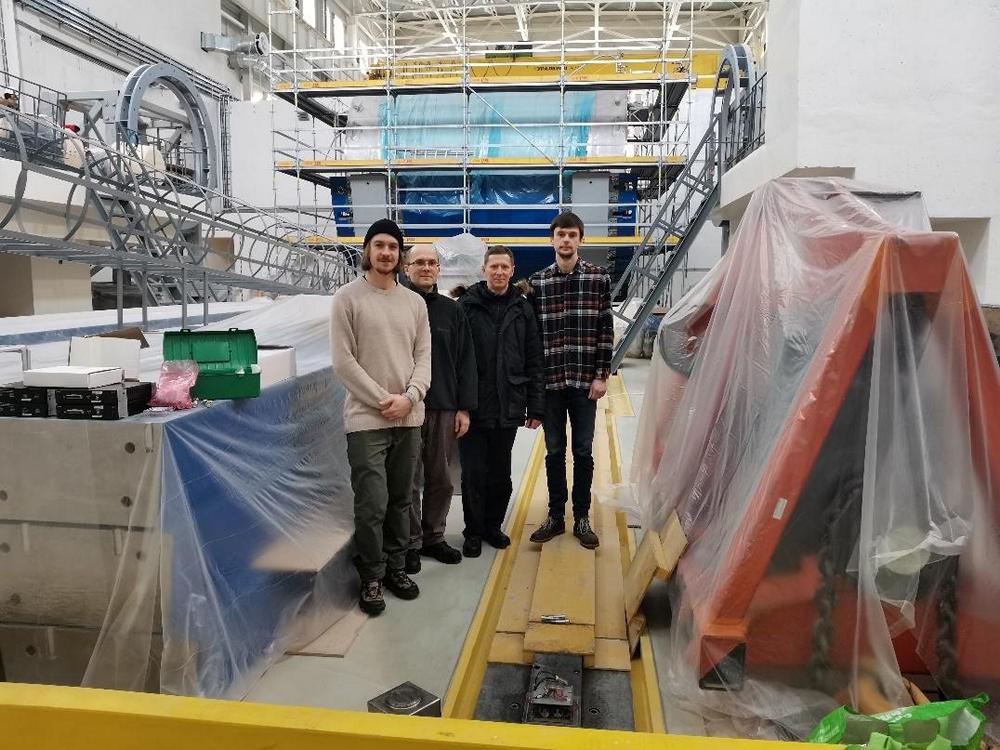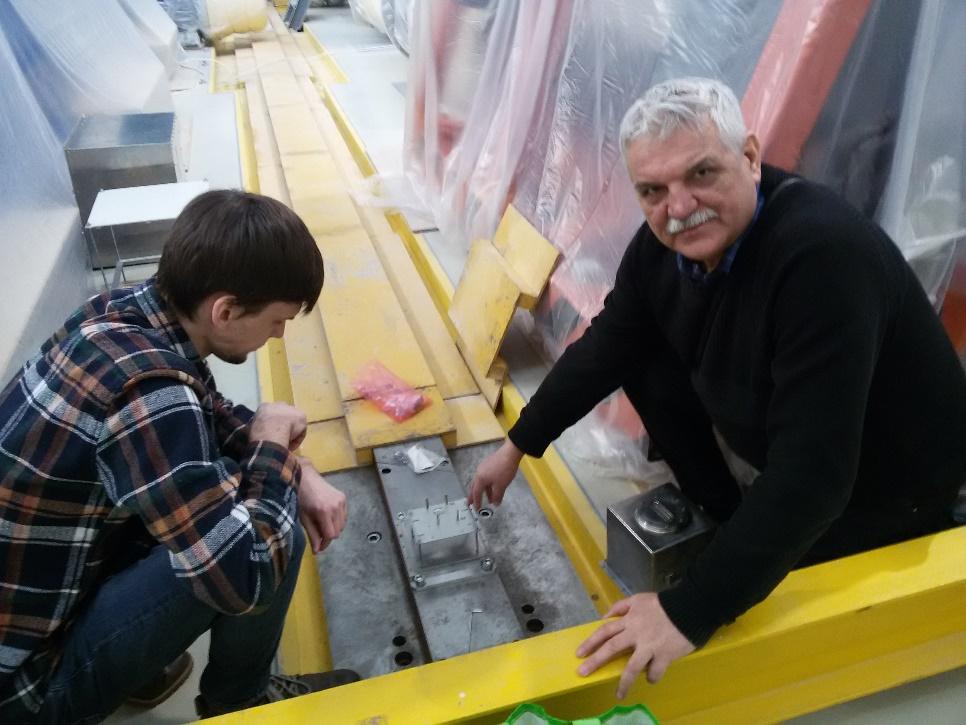Precision laser inclinometers for NICA
News, 16 March 2022
At the beginning of March 2022, two compact precision laser inclinometers (CPLI) were installed in the MPD hall of the NICA complex. With the help of these devices, scientists will be able to detect microseismic angular oscillations in order to assess their effect on the luminosity of the collider. Deputy Director of the Laboratory of Nuclear Problems JINR Vladimir Glagolev and the Head of sector No. 3 of the Multiple Hadron Processes Department (MHPD) DLNP Mikhail Lyablin commented on the event.
Using the CPLI, scientists will determine the intensity of angular oscillations of the Earth’s surface, which operate in the area of the NICA collider. Angular oscillations of the Earth’s surface create a kind of deformation of the collider, which eventually can affect the accuracy of beam convergence inside the MPD and SPD detectors. Significant angular oscillations of the collider base can lead to a change in its luminosity.
The CPLI registers the intensity and frequencies of angular oscillations of the Earth’s surface in a wide frequency range. This will allow determining the change in the geometry of the Earth’s surface under the collider online.
NICA is located not far from the technical zone of Dubna: the eastern heating plant of the town is located nearby, there is a bypass road for heavy trucks and a railway, a cryogenic workshop with powerful pumps operates on the VBLHEP site, Ivankovskaya Hydroelectric Power Plant with two turbines operates five kilometers away from the complex. That is, in fact, we are speaking about a large number of industrial noises. If their impact turns out to be significant, then the adjustment of the feedback system will become the next stage of work. It will allow neutralising or, at least, reducing the influence of these oscillations, stabilising beam convergence at the points of interactions and thus reducing the influence of microseisms on the luminosity of the collider. It is supposed to use two types of feedback: the placement of piezostackers that mechanically correct oscillations of the base under the accelerator elements, and the introduction of feedback on the power wirings of the accelerator elements, which will make it possible to correct the displacement of particle beams.
 Assembly of the MPD detector in the experimental hall. In the foreground, CPLI before the assembly on a special plate attached to the rail. In the photo from left to right: A. A. Pluzhnikov, A. M. Kuzkin , V. V. Glagolev, K. Polyakov
Assembly of the MPD detector in the experimental hall. In the foreground, CPLI before the assembly on a special plate attached to the rail. In the photo from left to right: A. A. Pluzhnikov, A. M. Kuzkin , V. V. Glagolev, K. Polyakov
The CPLI is, in fact, a compact version of a precision laser inclinometer, the inventors of which in 2014 were Mikhail Lyablin together with JINR DLNP Directorate Advisor Yulian Budagov (1932 – 2021). Two versions of the device operating on the same principle differ in their size and weight. In the experimental rooms of various experiments, specialists face the problem of limited space that is why MHPD DLNP decided to develop a smaller PLI for the convenience of the placement, meanwhile, the high sensitivity of the devices was maintained.
The CPLI weight is seven times less than its 70-kilogram predecessor. The size of the device has also changed: now it is enclosed in 20x20x20 cm metal case. Such inclinometers have recently been installed in the MPD hall. The network of 10 inclinometers of this type will be created around the perimeter of the NICA collider in order to get a full picture of the impact of industrial noises and outline actions to stabilise the luminosity of the collider in the area of the MPD and SPD detectors.
“MPD is the central point of the NICA accelerator, the colliding point of future beams,” Mikhail Lyablin said. “And the data collected here is extremely important for analysing and evaluating the situation with collider oscillations.”
Five PLIs of the first, large-sized version are currently serving for the benefit of science: they were installed at CERN at for CMS and ALICE experiments.
 K. Polyakov and M. V. Lyablin installing MPLI in MPD hall
K. Polyakov and M. V. Lyablin installing MPLI in MPD hall
“The device has a unique sensitivity,” Vladimir Glagolev notes. “It is able to register even the smallest oscillations from a person’s steps. An illustration of the PLI sensitivity is also the fact that inclinometers at CERN recorded a short-time decrease in luminosity caused by earthquakes in Latin America.”
The idea itself of stabilising collider installations from the effects of seismological oscillations is important, because it is possible to reduce the diameter of particle beams and, accordingly, increase the luminosity of the collider in the absence of beam oscillations of charged particles in colliders relative to each other. For example, scientists plan to increase the luminosity of the Large Hadron Collider tenfold within the HL-LHC programme. To do this, they need to re-equip the entire accelerator. However, theoretically there is another way: scientists can stabilise beams, reduce their diameter, and effectively increase the luminosity of the collider.
Laser inclinometers find quite an effective application in interferometric gravitational-wave antenna (IGA). So, the PLI have already been installed in the hall of the Northern Mirror of the IGA VIRGO to reduce the influence of oscillations of mirrors suspension. It is important to note that the development of compact PLIs has begun at the request of scientists working for VIRGO.
The scope of applications of precision laser inclinometers is not limited to the tasks of fundamental research. In this connection, the PLIs are able to help in the earthquake prediction. We shall remind that DLNP JINR scientists have already installed two PLIs at Garni Geophysical Observatory (Armenia).
Mikhail Lyablin explained that the basic idea of seismic forecasts using CPLIs is based on their ability to operate for a long time. “We can track changes in the landscape by observing a particular territory over a long period: we are talking about a year and more. These changes will allow us to determine seismic energy accumulation zones, i.e. zones of imminent earthquakes. This information is highly important for civil engineering planning in an earthquake-prone area. There are many tremors in a seismic energy accumulation zone immediately before an earthquake. They are precursors to an earthquake, monitoring which allows us to assess the situation and warn people about the danger,” he said.
According to the DLNP JINR scientists, CPLIs are at the forefront of seismological research. Currently, JINR, the Kamchatka branch of the Federal Research Centre “Joint Geophysical Service of RAS”, and Kamchatka State University named after Vitus Bering are signing an agreement on conducting joint research in this field. It is planned to install CPLIs in Uzbekistan for the same purpose.